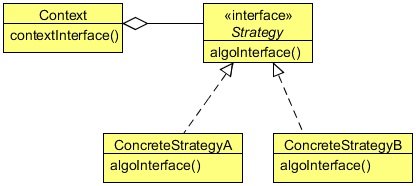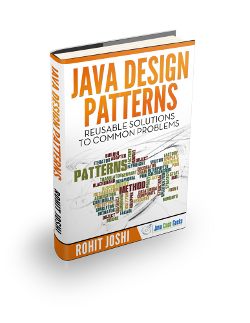Strategy Design Pattern Example
This article is part of our Academy Course titled Java Design Patterns.
In this course you will delve into a vast number of Design Patterns and see how those are implemented and utilized in Java. You will understand the reasons why patterns are so important and learn when and how to apply each one of them. Check it out here!
Table Of Contents
1. Introduction
The Strategy Design Pattern seems to be the simplest of all design patterns, yet it provides great flexibility to your code. This pattern is used almost everywhere, even in conjunction with the other design patterns. The patterns we have discussed so far have a relation with this pattern, either directly or indirectly. After this lesson, you will get an idea on how important this pattern is.
To understand the Strategy Design Pattern, let us create a text formatter for a text editor. Everyone should be aware of a text editor. A text editor can have different text formatters to format text. We can create different text formatters and then pass the required one to the text editor, so that the editor will able to format the text as required.
The text editor will hold a reference to a common interface for the text formatter and the editor’s job will be to pass the text to the formatter in order to format the text.
Let’s implement this using the Strategy Design Pattern which will make the code very flexible and maintainable. But before that, let us more about the Strategy Design Pattern.
2. What is the Strategy Pattern
The Strategy Design Pattern defines a family of algorithms, encapsulating each one, and making them interchangeable. Strategy lets the algorithm vary independently from the clients that use it.
The Strategy pattern is useful when there is a set of related algorithms and a client object needs to be able to dynamically pick and choose an algorithm from this set that suits its current need. The Strategy pattern suggests keeping the implementation of each of the algorithms in a separate class. Each such algorithm encapsulated in a separate class is referred to as a strategy. An object that uses a Strategy object is often referred to as a context object.
With different Strategy objects in place, changing the behavior of a Context object is simply a matter of changing its Strategy object to the one that implements the required algorithm. To enable a Context object to access different Strategy objects in a seamless manner, all Strategy objects must be designed to offer the same interface. In the Java programming language, this can be accomplished by designing each Strategy object either as an implementer of a common interface or as a subclass of a common abstract class that declares the required common interface.
Once the group of related algorithms is encapsulated in a set of Strategy classes in a class hierarchy, a client can choose from among these algorithms by selecting and instantiating an appropriate Strategy class. To alter the behavior of the context, a client object needs to configure the context with the selected strategy instance. This type of arrangement completely separates the implementation of an algorithm from the context that uses it. As a result, when an existing algorithm implementation is changed or a new algorithm is added to the group, both the context and the client object (that uses the context) remain unaffected.

Strategy
- Declares an interface common to all supported algorithms.
Contextuses this interface to call the algorithm defined by aConcreteStrategy.
ConcreteStrategy
- Implements the algorithm using the
Strategyinterface.
Context
- Is configured with a
ConcreteStrategyobject. - Maintains a reference to a
Strategyobject. - May define an interface that lets
Strategyaccess its data.
3. Implementing the Strategy Design Pattern
Below is the TextFormatter interface implement by all the concrete formatters.
package com.javacodegeeks.patterns.strategypattern;
public interface TextFormatter {
public void format(String text);
}
The above interface contains only one method, format, used to format the text.
package com.javacodegeeks.patterns.strategypattern;
public class CapTextFormatter implements TextFormatter{
@Override
public void format(String text) {
System.out.println("[CapTextFormatter]: "+text.toUpperCase());
}
}
The above class, CapTextFormatter, is a concrete text formatter that implements the TextFormatter interface and the class is used to change the text into capital case.
package com.javacodegeeks.patterns.strategypattern;
public class LowerTextFormatter implements TextFormatter{
@Override
public void format(String text) {
System.out.println("[LowerTextFormatter]: "+text.toLowerCase());
}
}
The LowerTextFormatter is a concrete text formatter that implements the TextFormatter interface and the class is used to change the text into small case.
package com.javacodegeeks.patterns.strategypattern;
public class TextEditor {
private final TextFormatter textFormatter;
public TextEditor(TextFormatter textFormatter){
this.textFormatter = textFormatter;
}
public void publishText(String text){
textFormatter.format(text);
}
}
The above class is the TextEditor class which holds a reference to the TextFormatter interface. The class contains the publishText method which forwards the text to the formatter in order to publish the text in desired format.
Now, let us test the code above.
package com.javacodegeeks.patterns.strategypattern;
public class TestStrategyPattern {
public static void main(String[] args) {
TextFormatter formatter = new CapTextFormatter();
TextEditor editor = new TextEditor(formatter);
editor.publishText("Testing text in caps formatter");
formatter = new LowerTextFormatter();
editor = new TextEditor(formatter);
editor.publishText("Testing text in lower formatter");
}
}
The above code will result to the following output:
[CapTextFormatter]: TESTING TEXT IN CAPS FORMATTER [LowerTextFormatter]: testing text in lower formatter
In the above class, we have first created a CapTextFormatter and assigned it to the TextEditor instance. Then we called the publishText method and passed some input text to it.
Again, we did the same thing, but this time, the LowerTextFormatter is passed to the TextEditor.
The output clearly shows the different text format produced by the different text editors due to the different text formatter used by it.
The main advantage of the Strategy Design Pattern is that we can enhance the code without much trouble. We can add new text formatters without disturbing the current code. This would make our code maintainable and flexible. This design pattern also promotes the “code to interface” design principle.
4. When to use the Strategy Design Pattern
Use the Strategy pattern when:
- Many related classes differ only in their behavior. Strategies provide a way to configure a class with one of many behaviors.
- You need different variants of an algorithm. For example, you might define algorithms reflecting different space/time trade-offs. Strategies can be used when these variants are implemented as a class hierarchy of algorithms.
- An algorithm uses data that clients shouldn’t know about. Use the Strategy pattern to avoid exposing complex, algorithm-specific data structures.
- A class defines many behaviors, and these appear as multiple conditional statements in its operations. Instead of many conditionals, move related conditional branches into their own
Strategyclass.
5. Strategy Pattern in JDK
java.util.Comparator#compare()javax.servlet.http.HttpServletjavax.servlet.Filter#doFilter()
6. Download the Source Code
This was a lesson on the Strategy Design Pattern. You may download the source code here: StrategyPattern-Project



